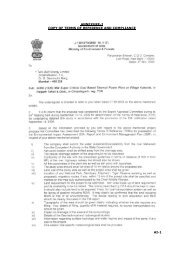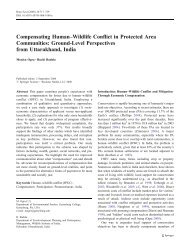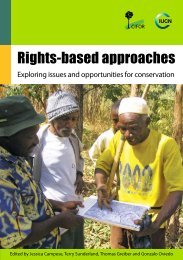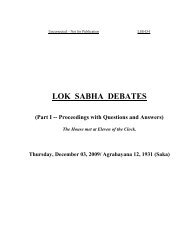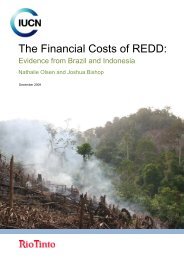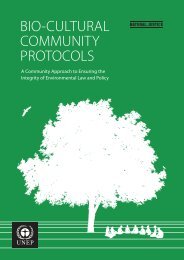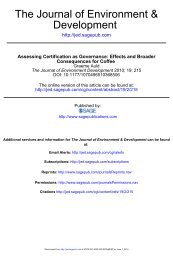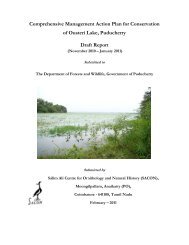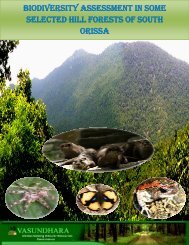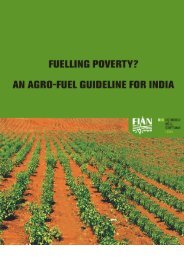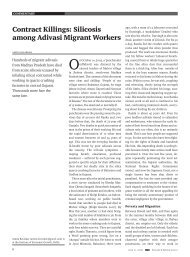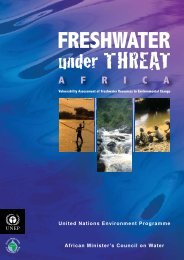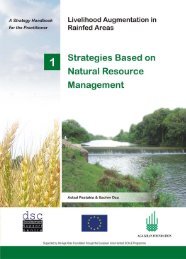Integrated River Basin Planning – Replicable ... - India Water Portal
Integrated River Basin Planning – Replicable ... - India Water Portal
Integrated River Basin Planning – Replicable ... - India Water Portal
Create successful ePaper yourself
Turn your PDF publications into a flip-book with our unique Google optimized e-Paper software.
<strong>Integrated</strong> <strong>River</strong> <strong>Basin</strong> <strong>Planning</strong>: <strong>India</strong> and the EU share experience on policy and practice<br />
Annex<br />
Nature of issue<br />
Cause<br />
ES<br />
Light problem<br />
Problem<br />
Important problem<br />
Very important problem<br />
Major problem<br />
A - SURFACE WATER RESOURCES - Pamba <strong>Basin</strong><br />
Qualitative Quantitative degradation reduction of of surface water quality water resources - Pamba <strong>Basin</strong><br />
Reduced Turbidity availability Impact Sandmining from sandmining 81 72<br />
Reduced Pathogenic availability contamination Encroachment Excreta 72 63<br />
<strong>Water</strong> Organic loss pollution Sedimentation Excreta of reservoirs 72 63<br />
Reduced Organic pollution availability Abstraction Urban waste for urban water supply 42 63<br />
Reduced Other pollution availability Long Waste term - plastic climatic changes 30 54<br />
Reduced Pesticide availability pollution Abstraction Agricultural for cropping rural water supply 28 42<br />
Pertubation Other chemical of runoff pollution Infrastructures Urban waste 27 24<br />
Reduced Eutrophication availability Impact Agricultural from cropping upstream dams 18 12<br />
Reduced Turbidity availability Abstraction Erosion for irrigation 14 12<br />
Pertubation Organic pollution of runoff Urbanisation Livestock 146<br />
Reduced Eutrophication availability Short Excreta term variability of precipitation 146<br />
<strong>Water</strong> Other chemical loss pollution Excessive Energy/transport evaporation 146<br />
Pertubation Organic pollution of runoff Modification Outlets from of food soils industries 50<br />
Reduced Eutrophication availability Abstraction Livestock for livestock 30<br />
Eutrophication Qualitative degradation Outlets of water from quality food industries resources - Pamba <strong>Basin</strong> 0<br />
Turbidity Eutrophication Sandmining Aquaculture 720<br />
Pathogenic Pesticide pollution contamination Excreta Livestock 630<br />
Organic Pesticide pollution Excreta Combat of disease vectors 630<br />
Organic Other chemical pollution pollution Urban Mines waste 630<br />
Other pollution chemical pollution Waste Outlets - from plastic industries 540<br />
Pesticide Match pollution between water quality needs Agricultural and the cropping available water quality of 42surface water<br />
Other chemical pollution resources Urban waste - Pamba <strong>Basin</strong><br />
24<br />
Eutrophication<br />
Demand for urban water supply Agricultural<br />
Insufficient water cropping<br />
quality 12<br />
48<br />
Turbidity<br />
Demand for rural water supply Erosion<br />
Insufficient water quality 12<br />
48<br />
Organic<br />
Demand pollution<br />
for environment Livestock<br />
Insufficient water quality 24<br />
6<br />
Eutrophication<br />
Demand from fisheries Excreta<br />
Insufficient water quality 24<br />
6<br />
Other<br />
Demand chemical<br />
for hydropower pollution Energy/transport<br />
Insufficient water quality 6<br />
B<br />
Demand - GROUNDWATER<br />
for livestock RESOURCES - Pamba<br />
Insufficient <strong>Basin</strong><br />
water quality 0<br />
Demand for irrigation Quantitative reduction<br />
Insufficient of groundwater<br />
water quality resources - Pamba <strong>Basin</strong><br />
0<br />
Reduced Demand from availability industries Long Insufficient term climatic water quality changes 480<br />
Pertubation Demand for of mining infiltration Urbanisation Insufficient water quality 180<br />
Reduced availability Short term variability of precipitation 8<br />
Reduced<br />
B - GROUNDWATER availability<br />
RESOURCES - Pamba Abstraction<br />
<strong>Basin</strong><br />
for rural water supply 4<br />
Qualitative<br />
Quantitative degradation<br />
reduction of of<br />
groundwater geoundwater<br />
resources resources<br />
- -<br />
Pamba Pamba<br />
<strong>Basin</strong><br />
<strong>Basin</strong><br />
Reduced availability Long term climatic changes 48<br />
Pathogenic contamination Excreta 81<br />
Pertubation of infiltration Urbanisation 18<br />
Organic pollution Excreta 81<br />
Reduced availability Short term variability of precipitation 8<br />
Pesticide pollution Agricultural cropping 7<br />
Reduced availability Abstraction for rural water supply 4<br />
Reduced availability Abstraction for urban water supply 0<br />
Reduced availability Abstraction for irrigation 0<br />
Reduced availability Abstraction for livestock 0<br />
Reduced availability Abstraction for industries 0<br />
Pertubation of infiltration Deforestation 0<br />
Pertubation of infiltration Modification of soils 0<br />
Pertubation of infiltration Irrigation schemes 0<br />
Match between water quantity needs and available quantity of groundwater resources -<br />
Pamba <strong>Basin</strong><br />
Demand for urban water supply Insufficient groundwater resources 0<br />
Demand for rural water supply Insufficient groundwater resources 0<br />
Demand for livestock Insufficient groundwater resources 0<br />
Demand for irrigation Insufficient groundwater resources 0<br />
Demand from industries Insufficient groundwater resources 0<br />
Demand for mining Insufficient groundwater resources 0<br />
Demand for tourism Insufficient groundwater resources 0<br />
Demand from ecosystems Insufficient groundwater resources 0<br />
Total demand/renewable res. Insufficient groundwater resources 0<br />
Nature of issue<br />
Cause<br />
ES<br />
Light problem<br />
Problem<br />
Important problem<br />
Very important problem<br />
Major problem<br />
Qualitative degradation of geoundwater resources - Pamba <strong>Basin</strong><br />
Pathogenic contamination Excreta 81<br />
Organic pollution Excreta 81<br />
Pesticide pollution Agricultural cropping 7<br />
Organic pollution Urban waste 0<br />
Organic pollution Livestock 0<br />
Organic pollution Outlets from food industries 0<br />
Organic pollution Aquaculture 0<br />
Pesticide pollution Livestock 0<br />
Pesticide pollution Combat of disease vectors 0<br />
Other chemical pollution Mines 0<br />
Other chemical pollution Industrial outlets 0<br />
Other chemical pollution Energy/transport 0<br />
Other chemical pollution Wastes 0<br />
Match between quality needs and available water quality of groundwater resources - Pamba<br />
<strong>Basin</strong><br />
Demand for rural water supply Insufficient groundwater quality 5<br />
Demand for urban water supply Insufficient groundwater quality 0<br />
Demand for livestock Insufficient groundwater quality 0<br />
Demand for irrigation Insufficient groundwater quality 0<br />
Demand from industries Insufficient groundwater quality 0<br />
Demand for mining Insufficient groundwater quality 0<br />
Demand from ecosystems Insufficient groundwater quality 0<br />
C - RISKS - Pamba <strong>Basin</strong><br />
Risks imposed through water resources - Pamba <strong>Basin</strong><br />
Soil erosion Floods, intensive pluviometry 63<br />
Loss of crops Floods 28<br />
Accidents (dam breaks, etc) Reservoirs 21<br />
Damage of infrastructure Floods, intensive pluviometry 18<br />
Increase of waterborne diseases Physical structures 0<br />
70 71



